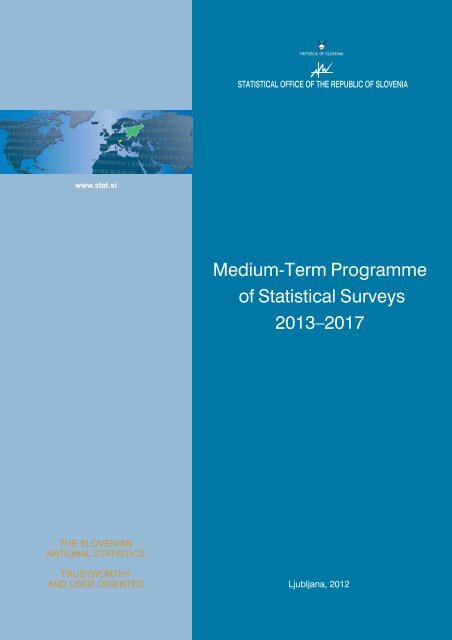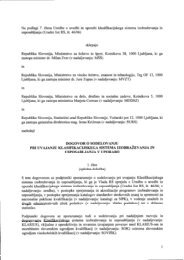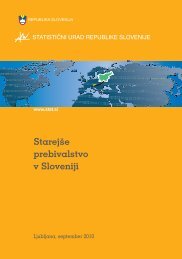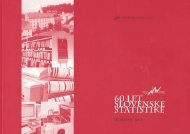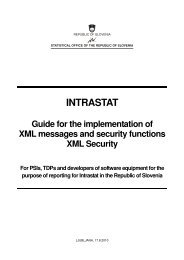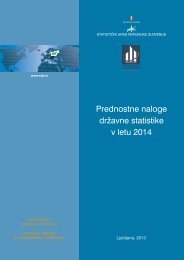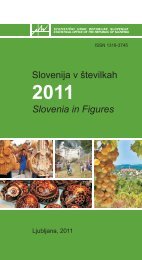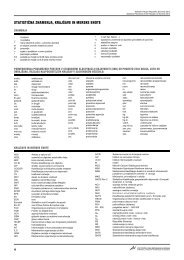Medium-Term Programme of Statistical Surveys 2013â2017
Medium-Term Programme of Statistical Surveys 2013â2017
Medium-Term Programme of Statistical Surveys 2013â2017
- No tags were found...
You also want an ePaper? Increase the reach of your titles
YUMPU automatically turns print PDFs into web optimized ePapers that Google loves.
REPUBLIC OF SLOVENIA<strong>Medium</strong>-<strong>Term</strong> <strong>Programme</strong><strong>of</strong> <strong>Statistical</strong> <strong>Surveys</strong>2013–2017Ljubljana, 2012
<strong>Medium</strong>-<strong>Term</strong> <strong>Programme</strong> <strong>of</strong> <strong>Statistical</strong> <strong>Surveys</strong> 2013–2017Authors: <strong>Statistical</strong> Office <strong>of</strong> the Republic <strong>of</strong> Slovenia, Agency <strong>of</strong> the Republic <strong>of</strong> Slovenia for Public LegalRecords and Related Services, Bank <strong>of</strong> Slovenia, National Institute <strong>of</strong> Public Health, Ministry <strong>of</strong> Finance,Pension and Disability Insurance Institute <strong>of</strong> the Republic <strong>of</strong> Slovenia and Employment Service <strong>of</strong>Slovenia.Editor: Alenka ŠkafarTranslation: Boris PaničThe publication is available at http://www.stat.si/eng/drz_stat_programi.aspCIP - Kataložni zapis o publikacijiNarodna in univerzitetna knjižnica, Ljubljana311.312(497.4)"2013/2017"(083.97)(0.034.2)MEDIUM term programme <strong>of</strong> statistical surveys 2013-2017 / [editor Alenka Škafar ;translation Boris Panič]. - Ljubljana : <strong>Statistical</strong> Office <strong>of</strong> the Republic <strong>of</strong> Slovenia, 2012Prevod dela: Srednjeročni program statističnih raziskovanj 2013-2017ISBN 978-961-239-261-11. Škafar Božič, Alenka264866816Issued by the <strong>Statistical</strong> Office <strong>of</strong> the Republic <strong>of</strong> Slovenia, Ljubljana, Litostrojska cesta 54 – Use andpublication <strong>of</strong> the data is allowed provided the source is acknowledged – ISBN 978-961-239-261-1.2
<strong>Medium</strong>-<strong>Term</strong> <strong>Programme</strong> <strong>of</strong> <strong>Statistical</strong> <strong>Surveys</strong> 2013–2017EVA: 2011-1522-0036No.: 96000-3/2012/4Date: 11. 10. 2012Pursuant to Article 23.b <strong>of</strong> the National Statistics Act (Official Journal <strong>of</strong> the Republic <strong>of</strong> Slovenia, No.45/95 and 9/01), the Government <strong>of</strong> the Republic <strong>of</strong> Slovenia at its 33 rd regular session on 11 October2012 adopted the followingDECISION:The Government <strong>of</strong> the Republic <strong>of</strong> Slovenia adopted the <strong>Medium</strong>-term <strong>Programme</strong> <strong>of</strong> <strong>Statistical</strong> <strong>Surveys</strong>2013–2017, which shall be published in the Official Journal <strong>of</strong> the Republic <strong>of</strong> Slovenia.Božo PREDALIČ, Ph.D.Secretary-General4
<strong>Medium</strong>-<strong>Term</strong> <strong>Programme</strong> <strong>of</strong> <strong>Statistical</strong> <strong>Surveys</strong> 2013–2017The <strong>Statistical</strong> Council <strong>of</strong> the Republic <strong>of</strong> Sloveniaat its 39 th regular session on 12 June 2012discussed the <strong>Medium</strong>-term <strong>Programme</strong> <strong>of</strong> <strong>Statistical</strong> <strong>Surveys</strong> 2013–2017and adopted the followingDECISIONS:1. The <strong>Statistical</strong> Council <strong>of</strong> the Republic <strong>of</strong> Slovenia at its 39 th regular session on 12 June 2012discussed the content <strong>of</strong> the <strong>Medium</strong>-term <strong>Programme</strong> <strong>of</strong> <strong>Statistical</strong> <strong>Surveys</strong> 2013–2017 andproposed that Director‐General <strong>of</strong> the <strong>Statistical</strong> Office <strong>of</strong> the Republic <strong>of</strong> Slovenia submits theprogramme to the Government <strong>of</strong> the Republic <strong>of</strong> Slovenia for adoption.2. The <strong>Statistical</strong> Council <strong>of</strong> the Republic <strong>of</strong> Slovenia recommends to the policy-makers that formonitoring the crisis and for helping to find a way out <strong>of</strong> it they use statistical data even more,since the statistical system provides a very useful data basis. The Council advises the media todemand <strong>of</strong>ficial data and quantitative calculations from the policy-makers.Anuška Ferligoj, Ph.D.President <strong>of</strong> the <strong>Statistical</strong> Council <strong>of</strong> the Republic <strong>of</strong> Slovenia5
<strong>Medium</strong>-<strong>Term</strong> <strong>Programme</strong> <strong>of</strong> <strong>Statistical</strong> <strong>Surveys</strong> 2013–20176
<strong>Medium</strong>-<strong>Term</strong> <strong>Programme</strong> <strong>of</strong> <strong>Statistical</strong> <strong>Surveys</strong> 2013–2017IntroductionThe <strong>Medium</strong>-term <strong>Programme</strong> <strong>of</strong> <strong>Statistical</strong> <strong>Surveys</strong> 2013–2017 determines the main objectives andpriority subject-matter areas <strong>of</strong> Slovene national statistics. The document is the fourth successive workprogramme <strong>of</strong> national statistics. It was prepared by the <strong>Statistical</strong> Office <strong>of</strong> the Republic <strong>of</strong> Slovenia, asthe main producer <strong>of</strong> national statistics, in cooperation with authorised producers <strong>of</strong> national statistics,namely the Agency <strong>of</strong> the Republic <strong>of</strong> Slovenia for Public Legal Records and Related Services, the Bank<strong>of</strong> Slovenia, the National Institute <strong>of</strong> Public Health, the Ministry <strong>of</strong> Finance, the Pension and DisabilityInsurance Institute <strong>of</strong> the Republic <strong>of</strong> Slovenia and the Employment Service <strong>of</strong> Slovenia.One <strong>of</strong> the main objectives <strong>of</strong> the medium-term programme <strong>of</strong> national statistics for the forthcoming fiveyearperiod is to increase the use <strong>of</strong> statistical data among users by timely detection <strong>of</strong> new initiatives andneeds for data and by ensuring quality, relevant and timely accessible statistical products and services. Atthe same time the <strong>Statistical</strong> Office and the authorised producers <strong>of</strong> national statistics will continue thework in the direction <strong>of</strong> preserving the confidence <strong>of</strong> all stakeholders and increasing the recognition <strong>of</strong>national statistics. Because the demand for statistical data at national and European level is increasingand the financial and human resources are increasingly limited, the activities must be implementedaccording to the cost-benefit principle, which means that in the next five years the key measures <strong>of</strong> the<strong>Statistical</strong> Office and authorised producers <strong>of</strong> national statistics will go in the direction <strong>of</strong> rationalisation <strong>of</strong>data collection with even more intensive use <strong>of</strong> administrative sources, constant advancement <strong>of</strong>statistical methodologies and use <strong>of</strong> the most appropriate information technologies.The preparation <strong>of</strong> different statistics and the development <strong>of</strong> individual fields <strong>of</strong> statistics are determinedby the needs <strong>of</strong> users. In designing and determining the most important development areas, initiativesgiven by users and expressed in various discussions, especially meetings <strong>of</strong> the <strong>Statistical</strong> Council andstatistical advisory committees, were taken into account as was the content <strong>of</strong> the proposal <strong>of</strong> theEuropean <strong>Statistical</strong> <strong>Programme</strong> 2013–2017 and the content <strong>of</strong> multiannual programmes <strong>of</strong> internationalinstitutions and other international initiatives. Priority subject-matter areas <strong>of</strong> national statistics in theprogramme refer to preparing and publishing <strong>of</strong> different indicators, production and development <strong>of</strong>appropriate data support for efficient economic governance at national and European level, improving theexisting and setting up new modules in environmental-economic accounts and better integration <strong>of</strong>individual statistics.I would like to thank everyone who cooperated in preparing this document. I am confident that theSlovene national statistics will prove to be trustworthy in measuring the progress and quality <strong>of</strong> life also inthe next five year-period.Irena KrižmanDirector-General <strong>of</strong> the <strong>Statistical</strong> Office<strong>of</strong> the Republic <strong>of</strong> Slovenia7
<strong>Medium</strong>-<strong>Term</strong> <strong>Programme</strong> <strong>of</strong> <strong>Statistical</strong> <strong>Surveys</strong> 2013–2017<strong>Medium</strong>-<strong>Term</strong> <strong>Programme</strong> <strong>of</strong> <strong>Statistical</strong> <strong>Surveys</strong> 2013–20171. Operational framework <strong>of</strong> the Slovene national statistics1.1 Legal and other basesThe operation <strong>of</strong> Slovene national statistics is stipulated by the National Statistics Act 1 (hereinafter theZDSta), which in Article 23 stipulates that the <strong>Statistical</strong> Office <strong>of</strong> the Republic <strong>of</strong> Slovenia (hereinafterSURS) together with authorised producers <strong>of</strong> national statistics prepares programmes <strong>of</strong> statisticalsurveys, both medium-term and annual. <strong>Medium</strong>-term programmes determine appropriate coverage <strong>of</strong>national and international policies as well as priorities, approaches, main areas and objectives <strong>of</strong> nationalstatistics, while annual programmes give a detailed overview <strong>of</strong> all statistical surveys by listing all maincomponents <strong>of</strong> the planned statistical survey. After adoption, each programme is published in the OfficialJournal <strong>of</strong> the Republic <strong>of</strong> Slovenia.The Slovene national statistics is part <strong>of</strong> the European <strong>Statistical</strong> System, so its operation is in line withthe Regulation on European Statistics 2 , while for individual fields <strong>of</strong> statistics Community statisticallegislation is in force 3 .The legal basis for pr<strong>of</strong>essional independence is given to the Slovene national statistics by the ZDSta; inpreserving objectivity and impartiality, it is based on the principles <strong>of</strong> the European Statistics Code <strong>of</strong>Practice 4 (which refer to institutional environment, statistical processes and statistical outputs); in itsoperation, it also takes into account methodological and classification standards and recommendations <strong>of</strong>various international institutions (e.g. the OECD, the United Nations and the International Monetary Fund).1.2 Slovene national statisticsSlovene national statistics is composed by the <strong>Statistical</strong> Office <strong>of</strong> the Republic <strong>of</strong> Slovenia andauthorised producers <strong>of</strong> national statistics (hereinafter authorised producers). In the <strong>Medium</strong>-<strong>Term</strong><strong>Programme</strong> <strong>of</strong> <strong>Statistical</strong> <strong>Surveys</strong> 2013−2017 the tasks and responsibilities <strong>of</strong> authorised producers wereassumed by the following institutions 5 (in alphabetical order):- Agency <strong>of</strong> the Republic <strong>of</strong> Slovenia for Public Legal Records and Related Services,- Bank <strong>of</strong> Slovenia,- Employment Service <strong>of</strong> Slovenia- National Institute <strong>of</strong> Public Health,- Ministry <strong>of</strong> Finance, and- Pension and Disability Insurance Institute.The operation <strong>of</strong> the national statistics is monitored by the <strong>Statistical</strong> Council <strong>of</strong> the Republic <strong>of</strong> Slovenia 6 ,which is a pr<strong>of</strong>essional methodological advisory body for strategic and development issues <strong>of</strong> nationalstatistics. Individual fields <strong>of</strong> statistics are monitored by statistical advisory committees 7 . Members <strong>of</strong> the<strong>Statistical</strong> Council and statistical advisory committees are representatives <strong>of</strong> the most important users <strong>of</strong>statistical data and representatives <strong>of</strong> data providers.1.3 Operation <strong>of</strong> the Slovene national statistics in the European <strong>Statistical</strong> System andother international cooperationSURS and authorised producers are actively cooperating in various European bodies and institutions.Cooperation is the most active with the <strong>Statistical</strong> Office <strong>of</strong> the European Union (Eurostat) and within theEuropean <strong>Statistical</strong> System (hereinafter the ESS). SURS and authorised producers also cooperate invarious statistical bodies and working groups <strong>of</strong> international organisations: the OECD (StatisticsDirectorate, Directorate for Employment, Labour and Social Affairs and various agencies), the UN1National Statistics Act, OJ RS, No. 45/95 and 9/2001: http://www.stat.si/eng/drz_stat_zakonski.asp (30.5. 2012)2Regulation (EC) No 223/2009 <strong>of</strong> the European Parliament and <strong>of</strong> the Council <strong>of</strong> 11 March 2009 on European statistics andrepealing Regulation (EC, Euratom) No 1101/2008 <strong>of</strong> the European Parliament and <strong>of</strong> the Council on the transmission <strong>of</strong> datasubject to statistical confidentiality to the <strong>Statistical</strong> Office <strong>of</strong> the European Communities, Council Regulation (EC) No 322/97 onCommunity Statistics, and Council Decision 89/382/EEC, Euratom establishing a Committee on the <strong>Statistical</strong> <strong>Programme</strong>s <strong>of</strong> theEuropean Communities (32009R0223).3See: http://epp.eurostat.ec.europa.eu/portal/page/portal/ess_eurostat/legislation_in_force (30. 5. 2012).4See: http://www.stat.si/eng/drz_stat_kakovost_kodeks.asp (30. 5. 2012).5In the annual programme <strong>of</strong> statistical surveys the institutions are stated beside each individual survey.6See: http://www.stat.si/eng/drz_stat_svet.asp (30. 5. 2012).7See: http://www.stat.si/eng/drz_stat_sosveti.asp (30. 5. 2012).8
<strong>Medium</strong>-<strong>Term</strong> <strong>Programme</strong> <strong>of</strong> <strong>Statistical</strong> <strong>Surveys</strong> 2013–2017(Conference <strong>of</strong> European Statisticians organised at the Economic Commission for Europe), the <strong>Statistical</strong>Commission and various specialised agencies, United Nations programmes and funds. They are alsoactively cooperating in various international pr<strong>of</strong>essional associations from the field <strong>of</strong> statistics, e.g. theInternational <strong>Statistical</strong> Institute (ISI) and its section the International Association for Official Statistics(IAOS), and in scientific and research institutions.SURS and authorised producers are also active in the field <strong>of</strong> international bilateral cooperation andinternational development cooperation with the purpose <strong>of</strong> developing and strengthening statistical systems,achieving progress in the quality <strong>of</strong> statistical methodologies and surveys, and promoting statistics.In addition to the ESS, at the European level there is also the European System <strong>of</strong> Central Banks(ESCB), a member <strong>of</strong> which is the Bank <strong>of</strong> Slovenia. For effective operation <strong>of</strong> both systems anagreement on the cooperation in the field <strong>of</strong> economic and financial statistics has been signed betweenthe Directorate General Statistics at the European Central Bank (ECB) and Eurostat. At the national level,a similar role is played by the agreement on cooperation in the field <strong>of</strong> macroeconomic and financialstatistics 8 between SURS, the Bank <strong>of</strong> Slovenia and the Ministry <strong>of</strong> Finance.1.4 Financing <strong>of</strong> the national statisticsThe financial stability is <strong>of</strong> key importance for pr<strong>of</strong>essional and independent operation <strong>of</strong> the Slovenenational statistics. All institutions will operate financially sustainable and take care <strong>of</strong> appropriate financialresources for performing the activity.As a pr<strong>of</strong>essionally independent Government agency, SURS is directly involved in the preparation andharmonisation <strong>of</strong> the national budget (Article 18 <strong>of</strong> the ZDSta). For performing the activity, SURS isfinanced from the national budget in accordance with the approved annual financial plan. Should later onSURS’s financial needs increase due to new or more extensive commitments (e.g. due to adopted EUlegislation), SURS should obtain additional financial resources or redistribute existing financial resources,depending on the agreement with the national budget manager and depending on the priorities and therelationship between costs, burdens and benefits. A smaller part <strong>of</strong> SURS’s income comes from financialresources obtained from European Commission tenders.Authorised producers finance the activity <strong>of</strong> national statistics from financial resources obtained from thebudget <strong>of</strong> the Republic <strong>of</strong> Slovenia. Because authorised producers are mostly not directly involved inpreparing and harmonising the national budget, during the financial crisis and decline in the financing <strong>of</strong>these institutions from the national budget the financing <strong>of</strong> national statistics could be put in jeopardy.2. Mission, vision, values and main factors <strong>of</strong> supporting activitiesMission <strong>of</strong> national statisticsNational statistics provides the public administration bodies and organisations, the economy and thegeneral public with quality and timely data on the situation and movements in the economic, demographicand social spheres and in the areas <strong>of</strong> the environment and natural resources. These data arecomparable in time, among places and internationally. Data for national needs and internationaldissemination are provided at optimal costs. Taking into account statistical confidentiality, it builds thetrust <strong>of</strong> users and data providers and strengthens the pr<strong>of</strong>essional autonomy.Vision <strong>of</strong> national statistics:- To be a trustworthy system friendly towards users and data providers- To be a modern system with the highest standards in the entire statistical process- To implement to the largest extent the principles <strong>of</strong> the European Statistics Code <strong>of</strong> Practice andthe ESCB Public Commitment on European Statistics- To provide appropriate working conditions for a pr<strong>of</strong>essional team <strong>of</strong> highly-motivated employees- To perform its activity in the most cost-effective way possibleValues <strong>of</strong> national statistics:- Pr<strong>of</strong>essional independence- Knowledge and experience <strong>of</strong> institutions- Information security- Trust <strong>of</strong> users and data providers- Pr<strong>of</strong>essional conduct <strong>of</strong> employees8See: http://www.stat.si/doc/drzstat/BS.MF.pdf (30. 5. 2012).9
<strong>Medium</strong>-<strong>Term</strong> <strong>Programme</strong> <strong>of</strong> <strong>Statistical</strong> <strong>Surveys</strong> 2013–2017Main factors <strong>of</strong> supporting activities <strong>of</strong> national statistics:The achievement <strong>of</strong> the main objectives <strong>of</strong> national statistics is provided by the so-called supportingactivities, which are in this document described in detail in Chapter 4 (Key areas <strong>of</strong> development andoperation <strong>of</strong> national statistics). Nevertheless, they are listed here:- Highly qualified, well organised and motivated employees- Legislation and good practice in preparing programmes <strong>of</strong> statistical surveys- Classifications, registers, statistical units- General methodology and methodological, organisational and process standards- Data collection and cooperation with keepers <strong>of</strong> data sources- ICT support and information security- Dissemination <strong>of</strong> statistical data and information and communication with the public- Active cooperation in the ESS and beyond- Active cooperation <strong>of</strong> authorised producers- Financial resources3. Main objectives <strong>of</strong> national statistics in the medium-term 2013–2017The medium-term programme determines the framework <strong>of</strong> national statistics: development, preparationand dissemination <strong>of</strong> statistical products and services. In determining the main objectives and activities forachieving them, national and European legal bases are considered as well as the needs and requests <strong>of</strong>Slovene, European and other international users, taking into account available resources (financial andhuman) and acknowledging changes and shifts in society. As a result, all this demands the determination <strong>of</strong>priorities, even greater flexibility <strong>of</strong> the statistical system in terms <strong>of</strong> data preparation, even more effectivecommunication with users so that statistical products and services are appropriate and useful for them, andconsistent consideration <strong>of</strong> reporting burden on one hand and costs <strong>of</strong> national statistics on the other.For the medium-term 2013-2017, SURS and authorised producers set the following main objectives:1. Increasing the use <strong>of</strong> statistical data2. Preserving the confidence <strong>of</strong> all stakeholders and increasing the recognition <strong>of</strong> nationalstatistics3. Implementing the activity according to the cost-benefit principleTo achieve these objectives, SURS and authorised producers will actively cooperate with partners inSlovenia, in the European <strong>Statistical</strong> System and the European System <strong>of</strong> Central Banks, and withvarious international institutions.Despite the increasing use <strong>of</strong> administrative data collections, for implementing the statistical activity somedata will still have to be collected directly from data providers (i.e. enterprises and other institutions,persons and households). In collecting these data the principle <strong>of</strong> non-excessive burden on respondentsis always taken into account. In this medium-term period activities will focus on cooperation with largerenterprises so that their reporting burden can be reduced.Managers (keepers) <strong>of</strong> administrative data collect and keep the data for non-statistical purposes andtransmit them to national statistics in line with the ZDSta for statistical purposes. With these keepersSURS signed agreements on data transmission, which enables it to have a say regarding possiblechanges in the data source and the stability <strong>of</strong> administrative data collections. In this medium-term period,too, the use <strong>of</strong> administrative data collections will be increased as much as possible. SURS andauthorised producers will intensively cooperate with keepers <strong>of</strong> data sources and strive to preserve thenecessary extent and quality <strong>of</strong> administrative data sources.Data providers are at the same time also users <strong>of</strong> statistical data, so all participating institutions will seeksynergies between the two roles in order to improve the quality <strong>of</strong> statistical results and to eliminateadministrative obstacles and reduce administrative burdens.Cooperation with users <strong>of</strong> statistical products and services will be strengthened and targeted. These aremanaging authorities (policy-makers), the economy, educational institutions, the scientific and researchcommunity, the civil society and the general public. <strong>Statistical</strong> data for the last two are the most frequentlyprovided by the media. Cooperation with the scientific and research community is also important for thedevelopment <strong>of</strong> statistical methodology and procedures and this is a two-way cooperation.An important role in the efforts to achieve the objectives is played by people employed in nationalstatistics; their pr<strong>of</strong>essional conduct and expertise will significantly contribute to high-quality statisticalproducts and services.10
<strong>Medium</strong>-<strong>Term</strong> <strong>Programme</strong> <strong>of</strong> <strong>Statistical</strong> <strong>Surveys</strong> 2013–20174.1.3 Development <strong>of</strong> statistical areas on the basis <strong>of</strong> cooperation in Slovenia, and in the European andinternational environment:- Organised and in-depth monitoring <strong>of</strong> changes and development <strong>of</strong> national policies andlegislation and transmission <strong>of</strong> opinions and remarks important for preparing anddisseminating statistics, including the provision <strong>of</strong> appropriate administrative data sources- Active membership <strong>of</strong> various working, expert and high-level groups and committees atEurostat, the ESCB and the CMFB- Active cooperation in groups and at meetings <strong>of</strong> other international organisations (i.e. theOECD, the UN ECE, the UN <strong>Statistical</strong> Commission)4.1.4 Development <strong>of</strong> statistical areas in cooperation with the scientific and research community:- Together with the scientific and research community, inclusion in projects for thedevelopment <strong>of</strong> statistical methodologies within the tendered research programmes <strong>of</strong> theEU and target research projects in Slovenia- Cooperation in data modelling and estimation- Encouraging researchers to use microdata for preparing various in-depth statisticalanalyses and models- Analysis <strong>of</strong> studies and transfer <strong>of</strong> knowledge from the scientific and research community t<strong>of</strong>urther use in the statistical process- Systematic verification <strong>of</strong> planned or already used statistical methodologies4.2 OBJECTIVE 2: Preserving the confidence <strong>of</strong> all stakeholders and increasing therecognition <strong>of</strong> national statisticsFor implementing its mission, national statistics must at least preserve the achieved level <strong>of</strong>confidence <strong>of</strong> all stakeholders and at the same time act so as to increase cooperation within the nationalstatistics system. Only high-quality statistical products and services will increase the recognition <strong>of</strong>national statistics as an institution and a trustworthy partner. SURS and authorised producers willimplement activities with which they will draw their activities closer to data providers, so that they willbetter understand why it makes sense to report the data and learn that the reported data are necessaryand important for various calculations and data dissemination, for monitoring the changes in the economyand the society and for monitoring their development.In preserving confidence one <strong>of</strong> the key elements is providing appropriate information protection,especially management <strong>of</strong> data sources. Within this context the security and protection <strong>of</strong> personal data<strong>of</strong> data providers should be emphasised, since only in this way they will continue to trust that SURS andauthorised producers manage their data responsibly. Therefore, by promoting this value, SURS andauthorised producers will strengthen public confidence in national statistics, which will result instrengthened cooperation with data providers and users.SURS and authorised producers want to increase the recognition <strong>of</strong> national statistics by makingusers aware that relevant, reliable and timely statistical data are and will continue to be available onSURS’s website and the websites <strong>of</strong> authorised producers, irrespective <strong>of</strong> who prepared the data (SURSor one <strong>of</strong> the authorised producers) and which field <strong>of</strong> statistics is involved.The following four tasks are <strong>of</strong> key importance for national statistics to achieve the second mainobjective.They will be implemented through several activities:4.2.1 Cooperation with data providers:- Strengthening the awareness <strong>of</strong> reporting units that in dealing with data national statisticstakes strict account <strong>of</strong> the aspect <strong>of</strong> information protection- Setting up rapid and efficient communication with people and households, with enterprisesand with keepers <strong>of</strong> administrative data sources- Strengthening personal contacts with people preparing the data, especially in largeenterprises- Updating and improving explanations and instructions on reporting for data providers4.2.2. Development <strong>of</strong> the quality <strong>of</strong> the Slovene national statistics:- Improvement <strong>of</strong> SURS’s coordination with authorised producers in achieving compliancewith the European Statistics Code <strong>of</strong> Practice12
<strong>Medium</strong>-<strong>Term</strong> <strong>Programme</strong> <strong>of</strong> <strong>Statistical</strong> <strong>Surveys</strong> 2013–2017- Taking care <strong>of</strong> compliance with the European Statistics Code <strong>of</strong> Practice in all areas;institutional environment, statistical processes and statistical results- Informing the users and data providers about the implementation <strong>of</strong> the principles <strong>of</strong> theEuropean Statistics Code <strong>of</strong> Practice and the ESCB Public Commitment on EuropeanStatistics at all authorised producers- Determination <strong>of</strong> quality framework elements (studying the possibility <strong>of</strong> quality systemmanagement according to EFQM principles)- Implementation <strong>of</strong> appropriate statistical procedures by considering the adopted guidelinesand manuals and detailed supporting documents- Implementation <strong>of</strong> procedures for quality monitoring in procedures <strong>of</strong> conducting statisticalsurveys- Introduction <strong>of</strong> selective reporting and data editing- Pr<strong>of</strong>essional assessment <strong>of</strong> statistical surveys (methodology used, reviewing the analysis <strong>of</strong>quality indicators, classifications used, etc.)- Expanding the role and activities <strong>of</strong> SURS’s Methodological Council- Improving the coherence between different fields <strong>of</strong> statistics4.2.3 Development <strong>of</strong> information security with the emphasis on personal data protection:- Implementing the fundamental principles <strong>of</strong> the umbrella security policy and rules <strong>of</strong>pr<strong>of</strong>ession and introducing the provisions <strong>of</strong> relevant rules into all statistical processes- Emphasising the importance <strong>of</strong> personal data protection within the development <strong>of</strong>information security and umbrella security policy- Introduction <strong>of</strong> anonimisation <strong>of</strong> personal data in the entire statistical process- Effective protection <strong>of</strong> personal data- Raising the awareness and culture <strong>of</strong> employees regarding the implementation <strong>of</strong>information security- Monitoring the development <strong>of</strong> information security standards and inclusion <strong>of</strong> novelties intothe umbrella security policy and relevant rules4.2.4 Strengthening pr<strong>of</strong>essional independence and recognition <strong>of</strong> national statistics:- Preservation <strong>of</strong> legal and other bases for independent operation <strong>of</strong> national statistics- Preservation and strengthening <strong>of</strong> the awareness <strong>of</strong> the principles <strong>of</strong> the EuropeanStatistics Code <strong>of</strong> Practice and the ESCB Public Commitment on European Statistics- Informing the public about the most appropriate statistical methods used for the preparation<strong>of</strong> high-quality statistical products and services- Drawing attention to misuse or misinterpretation <strong>of</strong> statistical results- Increasing the recognition <strong>of</strong> national statistics by setting up a single entry point to statisticaldata via websites <strong>of</strong> all authorised producers <strong>of</strong> national statistics4.3 OBJECTIVE 3: Implementing the activity according to the cost-benefit principleThe European Statistics Code <strong>of</strong> Practice and the ESCB Public Commitment on European Statisticsdetermine (each in its Principle 10) the cost-effectiveness; this means that all (re)sources (data, technical,human and financial) must be effectively used to achieve the best possible results, effects, benefits.Development <strong>of</strong> the society and the economy constantly imposes new tasks on national statistics(publication <strong>of</strong> new, different, more relevant statistical results); at the same time, there are also theexisting needs. One <strong>of</strong> the problems is that financial and human resources are increasingly limited. Thegap can partly be solved by optimising the processes <strong>of</strong> conducting statistical surveys, by introducingmore advanced statistical methodologies and appropriate information technologies and byredistributing human and financial resources.Improved, standardised and uniform statistical production will bring acceleration <strong>of</strong> different procedures,statistical sources will be used several times (the once-for-many-purposes principle), and it will bepossible to prepare new statistics by using different techniques <strong>of</strong> linking various data sources.For high-quality statistical products and services, high-quality input sources are necessary; SURS andauthorised producers must take care <strong>of</strong> non-excessive burden on respondents 10 . In this way SURS andauthorised producers can preserve and improve the response rate in statistical surveys.10Principle 9 <strong>of</strong> the European Statistics Code <strong>of</strong> Practice: taking care <strong>of</strong> non-excessive burden on respondents involves the greatestpossible use <strong>of</strong> existing administrative sources instead <strong>of</strong> direct data collection from enterprises, re-use <strong>of</strong> existing statisticalsources, use <strong>of</strong> statistical sampling methods, etc. It also involves constant preservation <strong>of</strong> the balance between the expressedneeds <strong>of</strong> users and actual possibilities <strong>of</strong> national statistics and data providers.13
<strong>Medium</strong>-<strong>Term</strong> <strong>Programme</strong> <strong>of</strong> <strong>Statistical</strong> <strong>Surveys</strong> 2013–2017Objective will be achieved:- By providing the necessary data from the fields <strong>of</strong> energy, water, environmental protectionexpenditure, environmental taxes, transport, agriculture and all human activities that haveimpact on the environment- By upgrading the established environmental accounts in the fields <strong>of</strong> air emissions,environmental taxes and material flow accounts, and by developing new areas, especiallyenvironmental expenditure accounts, environmental goods and services accounts, and energyaccounts; these will namely enable a comprehensive overview <strong>of</strong> environmental impacts5.3 Basic statisticsPriorities for the development <strong>of</strong> business and social statistics (People and the society), agriculture,environmental and other sectoral statistics and spatial statistics are presented. Timely basic statistics arethe basis for high-quality policy responses and as a result for measures to support economic and socialdevelopment. Basic statistics are input data for calculating various accounts and indicators, whileappropriately prepared (micro)data enable their use also for the research purpose and for modelling. In allstatistics the emphasis will be on even more effective reduction <strong>of</strong> reporting burden and the use <strong>of</strong>existing administrative and statistical sources. National statistics will reduce the reporting burden bycontinuing to implement electronic reporting and introducing it for surveys that are still conducted in aclassical (paper-and-pen) way.5.3.1 BusinessBusiness statistics are based on extensive use <strong>of</strong> administrative data sources (e.g. Tax Administration)and on data from annual reports (AJPES); these data are the basis for various statistics and accounts.Therefore, enterprises are to a large extent exempt from extensive reporting <strong>of</strong> financial data. However,not all data on the operation are available, so some <strong>of</strong> them must still be collected directly fromenterprises, even small ones. National statistics takes constant care <strong>of</strong> non-excessive burden <strong>of</strong>enterprises by using modern statistical procedures. Slovene national statistics strives to keep the existingelectronic method <strong>of</strong> data collection via AJPES (as an authorised producer <strong>of</strong> <strong>of</strong>ficial statistics) and use itwhen data come from accounting departments <strong>of</strong> enterprises, when data are collected from a largenumber <strong>of</strong> reporting units and in case <strong>of</strong> surveys with short periodicity. If the extent, content and quality <strong>of</strong>annual reports and administrative sources (e.g. tax and customs sources, record <strong>of</strong> registration forcompulsory social insurance) are kept at the present level, we will be able to preserve non-excessiveburden <strong>of</strong> the business community. Due to rapid changes in the business community and the need <strong>of</strong>economic policies to respond to them, short-term (monthly and quarterly) statistics are also veryimportant.Objectives <strong>of</strong> national statistics:Increased use <strong>of</strong> statistical data and increased user satisfaction by optimising statistical processesand upgrading methodologies in order to increase the quality <strong>of</strong> existing results and develop newareas.Regular and timely provision <strong>of</strong> data from price statistics, structural, short-term, external trade,tourism and other statistics related to enterprises by managing increasingly difficult conditions <strong>of</strong>operation in line with international requirements and standards.Better integration <strong>of</strong> business statistics.Development <strong>of</strong> monitoring <strong>of</strong> service activities.Objectives will be achieved:- By further developing the statistical business register so that it will be a quality basis for furtherstatistical processes- By optimising processes in structural business statistics and the investment survey- By linking existing data, new data from service production, external trade, businessdemography, enterprise groups and tourism will be developed- By improving the quality <strong>of</strong> external trade statistics (which will be achieved by optimisingstatistical process and with subject-matter, organisational and technological upgrade <strong>of</strong> theIntrastat system within the ESS)- By annual implementation <strong>of</strong> the survey on financing <strong>of</strong> non-financial companies (in line withECB and European Commission surveys)18
<strong>Medium</strong>-<strong>Term</strong> <strong>Programme</strong> <strong>of</strong> <strong>Statistical</strong> <strong>Surveys</strong> 2013–2017- By setting up multi-purpose statistics by linking the fields <strong>of</strong> consumer price statistics andpurchasing power parities, by introducing detailed COICOP 17 classification and by using newtools for recording and presenting prices- By developing and improving the quality <strong>of</strong> real estate statistics and by setting up themonitoring <strong>of</strong> events on real estate markets (improving the quality <strong>of</strong> the Real Estate Register incooperation with the Surveying and Mapping Authority and the Ministry <strong>of</strong> the Interior,improving the quality <strong>of</strong> the sources <strong>of</strong> data on real estate prices, improving the quality <strong>of</strong>housing statistics)- By improving the quality <strong>of</strong> R&D and innovation statistics, also by using new data sources,methodological solutions and tools- By upgrading the collection and preparation <strong>of</strong> data on continuing vocational training inenterprises- By optimising data collection for tourism statistics5.3.2 People and the societyThe importance <strong>of</strong> social statistics is growing – this is pointed out by the mentioned Stiglitz-Sen-FitoussiReport. New initiatives encourage cooperation in developing and using new indicators (objective andsubjective), both indicators for measuring well-being and the quality <strong>of</strong> life as well as indicators formonitoring the implementation <strong>of</strong> the Europe 2020 Strategy with the emphasis on multidimensionality <strong>of</strong>social phenomena and solving some important challenges <strong>of</strong> statistical monitoring, such as health andpopulation ageing.Slovene national statistics is register-oriented, which enables data linking, further analyses andpreparation <strong>of</strong> derived statistics. High quality <strong>of</strong> sources is proven by the practice <strong>of</strong> researchers usingmicrodata for supporting various policies.Objectives <strong>of</strong> national statistics:Providing timely, quality and internationally comparable data that are the basis for comprehensive,multipurpose monitoring <strong>of</strong> well-being and progress <strong>of</strong> society, individuals and subgroups <strong>of</strong>population, for planning social policies and for making the right decisions.Linking and integration <strong>of</strong> different data sources and as a result reducing the reporting burden.More rational and even better implementation <strong>of</strong> surveys by setting up and using some databasesand information systems within and outside the national statistics system (e.g. records that servenational statistics as administrative data sources for statistical surveys).Objectives will be achieved:- By upgrading social statistics – technologically, methodologically and in terms <strong>of</strong> subject-matter– and effectively using administrative sources. Special attention will be focused on furtherdevelopment and use <strong>of</strong> new tools, knowledge and statistical procedures, linking <strong>of</strong> sources,reducing the reporting burden and more extensive and intensive use <strong>of</strong> already collectedstatistical data- By linking different administrative and statistical data sources, the register-based census <strong>of</strong>population, households and housing will again be conducted (as it was on 1 January 2012) fordisseminating social, economic and other characteristic <strong>of</strong> total population and individualsubgroups <strong>of</strong> population at different territorial levels- By closely cooperating with keepers <strong>of</strong> administrative data sources with the aim to preserve thequality <strong>of</strong> statistics – in setting up new sources as well as in possible abandoning <strong>of</strong>administrative sources, e.g. for calculating wage statistics, job vacancy statistics, etc.- By a comprehensive (and analytical) approach to treating social phenomena – in time andspace – in different areas and by linking social, economic and environmental factors and byupgrading objective statistical information and indicators with subjective monitoring <strong>of</strong> thequality <strong>of</strong> life- By a comprehensive approach to treating the activities <strong>of</strong> public and private providers <strong>of</strong>services from the fields <strong>of</strong> education, health, social protection, culture and research activity (bylinking different physical and financial data and indicators by individual activities and by types <strong>of</strong>service providers)- By conducting regular surveys and providing data and indicators from the field <strong>of</strong> livingconditions, labour market, social inclusion, long-term care, education and mobility <strong>of</strong> youngpeople, culture, health, migration and demography- By further implementation <strong>of</strong> the household finance and consumption survey within the ESCB(every three years)17Classification <strong>of</strong> Individual Consumption by Purpose.19
<strong>Medium</strong>-<strong>Term</strong> <strong>Programme</strong> <strong>of</strong> <strong>Statistical</strong> <strong>Surveys</strong> 2013–2017- By modules to basic surveys in accordance with the financial capacity and additional financingby the European Union or the government (this way national statistics will solve additionalrequests that will appear in the social field)5.3.3 Environmental, agricultural and other sectoral statisticsHigh-quality and reliable statistics from the fields <strong>of</strong> environment, agriculture, energy and transport are thebasis for studying and analysing each <strong>of</strong> these fields and for studying the interaction and integrationbetween the mentioned fields. Intersectoral integration will enable the introduction <strong>of</strong> systems solutions inpolicy preparation and making.Objectives <strong>of</strong> national statistics in the field <strong>of</strong> environmental statistics:Setting up the data basis for monitoring many complex pressures on the environment the result <strong>of</strong>which is pollution or air, water and soil, waste generation and disposal, loss <strong>of</strong> biodiversity, noise,etc.Preservation or improvement <strong>of</strong> data quality in environmental statistics because they are the basisfor different environmental accounts and indicators by taking constant care <strong>of</strong> reporting burden andits reduction.Objectives will be achieved:- By updating and adjusting water statistics with national and international requirements; to thisend cooperation with other actors from the field <strong>of</strong> water management (e.g. SlovenianEnvironment Agency, Ministry <strong>of</strong> Agriculture and Spatial Planning, Institute for Water, etc.) willstrengthen and data collection will be harmonised and modernised- By cooperating with the Ministry <strong>of</strong> Infrastructure and the Environment in setting up thedatabase on public water supply, sewerage system, collected municipal waste andmanagement <strong>of</strong> municipal waste. In line with the requirements for quality data, gradual takeover<strong>of</strong> administrative data sources and related gradual abandoning <strong>of</strong> direct data collection will takeplace, which will significantly reduce the reporting burden- By supplementing waste statistics in order to meet the requirements <strong>of</strong> the Waste StatisticsRegulation 18 in the field <strong>of</strong> import and export <strong>of</strong> wasteObjectives <strong>of</strong> national statistics in the field <strong>of</strong> agricultural statistics:Preservation <strong>of</strong> non-excessive burden on reporting units despite increased needs for data by usinghigh-quality administrative data sources and by influencing the requirements <strong>of</strong> the Directorate-General for Agriculture and Rural Development (DG AGRI).Providing data bases in statistical areas with which it will be possible to measure the impact <strong>of</strong>agriculture on the environment.Objectives will be achieved:- By monitoring the development <strong>of</strong> secondary data sources in the field <strong>of</strong> agriculture, fishery andforestry and by methodological improvements within agriculture statistics; it will be necessary tocooperate with the competent ministry- By actively cooperating in international discussions about the changes in farm structure surveysand other agriculture statistics- By first implementation <strong>of</strong> the statistical survey on pesticide use in line with common EUmethodologyObjectives <strong>of</strong> national statistics in the fields <strong>of</strong> energy statistics and transport statistics:<strong>Statistical</strong> support to monitoring the implementation <strong>of</strong> sectoral policies – data from the fields <strong>of</strong>renewable energy sources and efficient energy use are becoming increasingly important fromeconomic and social aspects and from the aspect <strong>of</strong> sustainable development.Provision <strong>of</strong> data for preparing statistics on transport safety and the impact <strong>of</strong> transport on theenvironment and for statistical monitoring <strong>of</strong> intermodality.Objectives will be achieved:- By calculating and publishing time series <strong>of</strong> data on renewable energy sources- By preparing the methodology and introducing statistics for monitoring energy and fuelconsumption in service activities- By monitoring the development <strong>of</strong> administrative data sources from the field <strong>of</strong> energy andtransport and taking over appropriate sources- By cooperating with competent ministries and the scientific community18Regulation (EC) No. 2150/2002 <strong>of</strong> the European Parliament and <strong>of</strong> the Council <strong>of</strong> 25 November 2002 on waste statistics(32002R2150).20
<strong>Medium</strong>-<strong>Term</strong> <strong>Programme</strong> <strong>of</strong> <strong>Statistical</strong> <strong>Surveys</strong> 2013–20175.3.4 Spatial statistics (geostatistics)Spatial statistics are highly cross-cutting since these statistics present and disseminate various datarelated to territorial units – from the smallest to the entire territory <strong>of</strong> Slovenia. These statistics arebecoming increasingly important for users because they are the basis for effective implementation <strong>of</strong>cohesion policy (economic, social and territorial cohesion), which in connection with the Europe 2020Strategy and the Slovenia’s Development Strategy 2013–2020 strive for growth, well-being and balanceddevelopment <strong>of</strong> Slovenia and the EU.Objectives <strong>of</strong> national statistics:Providing as large as possible number <strong>of</strong> timely and quality statistical data from different fields <strong>of</strong>statistics, presented at the lowest possible territorial level and in accordance with user needs.Dissemination <strong>of</strong> spatial data in different publication types and formats – depending on differentuser groups.Objectives will be achieved:- By expanding the set <strong>of</strong> statistical data presented and disseminated to users at differentterritorial levels (administrative units and hierarchical grids <strong>of</strong> various sizes and differentpublication formats) – providing appropriate statistical data protection and appropriate quality <strong>of</strong>regional data as this is the basis for presenting and disseminating spatial data- By developing different web applications that will enable visualisation and presentation <strong>of</strong>statistical data in space. The applications will be adjusted to various user groups (including themost demanding users with GIS tools that enable further processing and analysis <strong>of</strong> statisticaldata in space)- By simplifying user access to spatial statistical data – all in one place21
<strong>Medium</strong>-<strong>Term</strong> <strong>Programme</strong> <strong>of</strong> <strong>Statistical</strong> <strong>Surveys</strong> 2013–20176. Risk assessment for national statistics 19Risk description Probability1. ASSESSING THE NEED FOR STATISTICAL DATAThe needs for statistical data are not appropriatelydetected2. PREPARATION OF STATISTICAL DATATemporal limitation for implementing all phases <strong>of</strong>preparing a statistical surveyInsufficient and/or inappropriate cooperation <strong>of</strong> otherinstitutions in preparing administrative data sourcesInsufficient and/or inappropriate cooperation <strong>of</strong> otherinstitutions in defining the necessary contentConsequencessmall mediumMeasureFurther monitoring <strong>of</strong> user needs at the meetings <strong>of</strong> statisticaladvisory committees and within other associations, with customersatisfaction surveys, at conferences, and from information obtainedfrom users who visited the Information Centremedium medium Appropriate monitoring <strong>of</strong> user needsmedium medium Cooperation with institutions at the highest (management) levelsmall medium Cooperation with institutions at the highest (management) levelHuman resources unqualified for implementing the tasks medium large Appropriate planning <strong>of</strong> training activitiesDelay in preparing EU legislation medium medium Cooperation in European Commission/Eurostat bodies3. PREPARATION OF TOOLS FOR CONDUCTING STATISTICAL SURVEYSInappropriate human resources in the field <strong>of</strong> IT andother infrastructural areaslarge largeDependence on external IT service providers large largeIncorrectly prepared instructions for preparing variouss<strong>of</strong>tware applicationsRegular care <strong>of</strong> human resource trainingTransfer <strong>of</strong> some knowledge and products to national statisticsinstitutionslarge large Checking the quality <strong>of</strong> the steps in the processFinancial restraints for preparing instruments large large Appropriate planning <strong>of</strong> financial resources4. DATA COLLECTIONAbolition or degradation <strong>of</strong> administrative sources mediumExcessive burden on respondents (enterprises, persons,households, farms) with statistical and other (market)questionnaires and administrative burdensOut-<strong>of</strong>-date data sources for preparing sampling framesand lists <strong>of</strong> reporting unitsmedium mediumlarge Cooperation with the keepers <strong>of</strong> administrative data sources andthe Ministry <strong>of</strong> Justice and Public AdministrationUse <strong>of</strong> administrative data sources, electronic reporting, use <strong>of</strong>existing records in enterprisesmedium medium Monitoring the demography <strong>of</strong> reporting units in the field19National statistics is the <strong>Statistical</strong> Office <strong>of</strong> the Republic <strong>of</strong> Slovenia and authorised producers <strong>of</strong> national statistics.22
<strong>Medium</strong>-<strong>Term</strong> <strong>Programme</strong> <strong>of</strong> <strong>Statistical</strong> <strong>Surveys</strong> 2013–2017Risk description ProbabilityLow response <strong>of</strong> reporting units medium5. STATISTICAL DATA PROCESSINGInadequate organisation <strong>of</strong> the management <strong>of</strong>administrative sourcesInadequate preparation and implementation <strong>of</strong> statisticaldata processing (logical controls, selective editing,imputation, etc.)6. ANALYSIS OF STATISTICAL RESULTSConsequenceslargeInadequately prepared statistical results medium largeDisclosure <strong>of</strong> confidential statistical data (microdata,aggregate data or protected data) before releaseMeasureMotivation <strong>of</strong> reporting units (leaflets), improvement <strong>of</strong>questionnaires, appropriate communication with reporting units,providing various channels for data reporting, joining <strong>of</strong> surveyssmall medium Analysis <strong>of</strong> the possibility <strong>of</strong> changing the processmedium medium Quality control <strong>of</strong> instructions and steps <strong>of</strong> processessmall largeAppropriate communication with data users and training <strong>of</strong> authors<strong>of</strong> contributions, feedback from users (customer satisfactionsurveys)Taking into account appropriate data protection processes,procedures and standardsHuman resources unqualified for implementing the tasks medium large Appropriate planning <strong>of</strong> training activities7. DISSEMINATIONDelay in announced releases <strong>of</strong> statistical data medium mediumMonitoring the process <strong>of</strong> preparing the data and changing theagendaMethod <strong>of</strong> publication not user-friendly small large Monitoring customer satisfactionPublished data are not correct small large Monitoring the process in terms <strong>of</strong> qualityDependence on external IT service providers large largeTransfer <strong>of</strong> some knowledge and products to national statisticsinstitutionsFinancial restraints large large Providing financial resources8. BUDGET AND FINANCIAL OPERATIONSChange and reduction <strong>of</strong> planned budgets for SURS andauthorised producerslarge largePreparation <strong>of</strong> a backup planIneligible or improper use <strong>of</strong> funds small medium Control and immediate correctionBudget implementation – taking over commitments at thebudget item/account/Plan <strong>of</strong> Development <strong>Programme</strong>saccording to the plansmall medium Current monitoring <strong>of</strong> taking over the commitmentsCommitments not implemented in time medium medium Greater supervision9. PROCUREMENT AND RELATED ACTIVITIESCorrect implementation <strong>of</strong> public procurementproceduresmedium large Monitoring legislation23
<strong>Medium</strong>-<strong>Term</strong> <strong>Programme</strong> <strong>of</strong> <strong>Statistical</strong> <strong>Surveys</strong> 2013–2017Risk description ProbabilityConsequencesContract does not contain all elements medium large Improvement <strong>of</strong> internal controlIncorrect preparation <strong>of</strong> the investment decision andinclusion into the budget (non-inclusion <strong>of</strong> the investmentinto the budget, inappropriate preparation <strong>of</strong> investmentdocumentation)10. INFORMATION PROTECTIONAccess <strong>of</strong> unauthorised persons to statistical, personaland confidential datamedium mediumsmall largeInadequate data storage medium large Documented procedures11. INFORMATION INFRASTRUCTURE AND TECHNOLOGYPreparation <strong>of</strong> inadequate and untimely s<strong>of</strong>twaresolutionsInadequate command and maintenance <strong>of</strong> IT solutions byexternal service providersmedium largelargelargeIneffective operation <strong>of</strong> the information system medium large12. HUMAN RESOURCESInadequate number <strong>of</strong> employees for implementing theAnnual <strong>Programme</strong> <strong>of</strong> <strong>Statistical</strong> <strong>Surveys</strong>large largeSelection <strong>of</strong> inadequate human resources medium largeMeasurePrior internal control – preparation <strong>of</strong> the investment decision andinclusion into the budgetImplementation and improvement <strong>of</strong> the security policy, safearchitecture <strong>of</strong> the network and applications, continuous updating <strong>of</strong>s<strong>of</strong>tware with corrections, firewall, anti-virus protection, passwords,security assessment, documented procedures, raising awarenessand training <strong>of</strong> employees, secure room for access to confidentialdataImproving the competence <strong>of</strong> internal providers with regulartraining, regular cooperation with survey managers, andappropriate preparation <strong>of</strong> requestsImproving the competence <strong>of</strong> participants with external providersand gradual takeover <strong>of</strong> individual solutions, provision <strong>of</strong> financialresources, appropriate maintenance contractsClear custodianship, preventive maintenance, provision <strong>of</strong>redundancy and backup equipment, provision <strong>of</strong> financialresources, plan <strong>of</strong> modernising the IT infrastructure, checkingresults in cooperation with usersMaintaining a sufficient number <strong>of</strong> employees for implementing theAnnual <strong>Programme</strong> <strong>of</strong> <strong>Statistical</strong> <strong>Surveys</strong>Appropriate planning <strong>of</strong> commissions, appropriate composition <strong>of</strong>commissionsHuman resources unqualified for implementing the tasks medium large Appropriate planning <strong>of</strong> training activitiesCooperation between sectors in implementing the Annual<strong>Programme</strong> <strong>of</strong> <strong>Statistical</strong> <strong>Surveys</strong>medium large Appropriate planning <strong>of</strong> tasksFluctuation <strong>of</strong> human resources medium largeTaking care <strong>of</strong> workplace satisfaction, appropriate remuneration,analysis <strong>of</strong> the reasons for fluctuationSick leave medium medium Providing appropriate replacement, analysis <strong>of</strong> reasons24
<strong>Medium</strong>-<strong>Term</strong> <strong>Programme</strong> <strong>of</strong> <strong>Statistical</strong> <strong>Surveys</strong> 2013–2017List <strong>of</strong> abbreviationsAJPESBSCMFBEBAECBEFQMESAESACESCBESSEUFINREPGDPGISIAOSICTITJEGROECDR&DSURSUNECEAgency <strong>of</strong> the Republic <strong>of</strong> Slovenia for Public Legal Records and Related ServicesBank <strong>of</strong> SloveniaCommittee on Monetary, Financial and Balance <strong>of</strong> Payments StatisticsEuropean Banking AuthorityEuropean Central BankEuropean Foundation for Quality ManagementEuropean System <strong>of</strong> AccountsEuropean <strong>Statistical</strong> Advisory CommitteeEuropean System <strong>of</strong> Central BanksEuropean <strong>Statistical</strong> SystemEuropean UnionFINancial REPortingGross domestic productGeographic Information SystemInternational Association for Official StatisticsInformation and communication technologyInformation technologyJoint Expert Group on ReconciliationOrganisation for Economic Co-operation and DevelopmentResearch and Development<strong>Statistical</strong> Office <strong>of</strong> the Republic <strong>of</strong> SloveniaUnited Nations Economic Commission for Europe25


